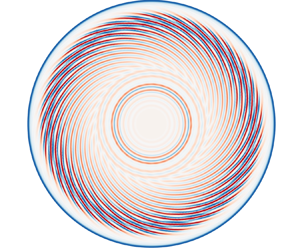Article contents
Onset of turbulence in rotor–stator cavity flows
Published online by Cambridge University Press: 28 August 2024
Abstract

Numerous studies have indicated that turbulence typically initiates along the boundary layer of the stationary disk within a rotor–stator cavity. To describe the transition process to turbulence on the stationary side of a closed rotor–stator cavity, a comprehensive approach combining global linear stability analysis with direct numerical simulation was adopted in the present study. The proposed model aligns with that of Yim et al. (J. Fluid Mech., vol. 848, 2018, pp. 631–647), who investigated the stability characteristics of the rotating-disk boundary layer in a rotor–stator cavity. In order to achieve a stable inflow for the stationary-disk boundary layer, we rotate the shroud together with the rotating disk. Through careful global stability analysis, the predominant spiral mode exhibiting the highest instability in the boundary layer of the stationary disk was discerned, corroborating observations from simulations. Initially, the spiral mode undergoes linear amplification, reaches a state of linear saturation and enters the nonlinear regime. Following nonlinear saturation in the flow field, a circular wave mode arises due to the influence of mean flow distortion. As the Reynolds number attained a sufficiently high level, the interplay between the downstream-propagating circular mode and spiral mode amplified disturbances in the boundary layer of the stationary disk, ultimately leading to the development of localised turbulence at the mid-radius of the rotor–stator cavity. Notably, the present study is the first to elucidate the coexistence of laminar–transitional–turbulent flow states in the stationary-disk boundary layer through direct numerical simulations.
Information
- Type
- JFM Papers
- Information
- Copyright
- © The Author(s), 2024. Published by Cambridge University Press.
References
- 7
- Cited by


